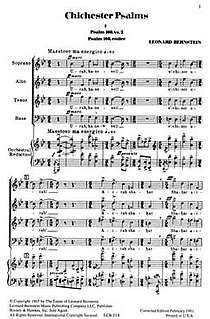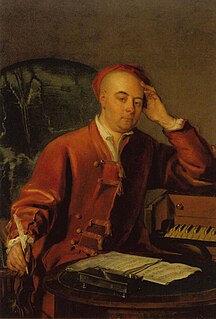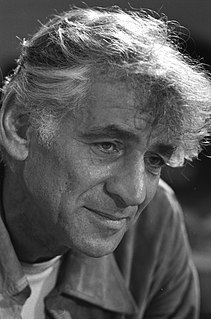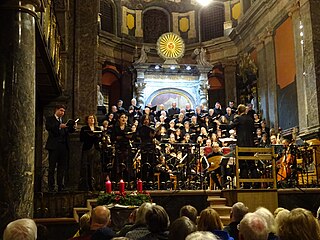The Armed Man is a mass by Welsh composer Karl Jenkins, subtitled "A Mass for Peace". The piece was commissioned by the Royal Armouries Museum for the Millennium celebrations, to mark the museum's move from London to Leeds, and it was dedicated to victims of the Kosovo crisis. Like Benjamin Britten's War Requiem before it, it is essentially an anti-war piece and is based on the Catholic Mass, which Jenkins combines with other sources, principally the 15th-century folk song "L'homme armé" in the first and last movements. It was written for SATB chorus with soloists and a symphonic orchestra. Guy Wilson, then master of the museum, selected the texts for the mass.

Chichester Psalms is an extended choral composition in three movements by Leonard Bernstein for boy treble or countertenor, choir and orchestra. The text was arranged by the composer from the Book of Psalms in the original Hebrew. Part 1 uses Psalms 100 and 108, Part 2 uses 2 and 23, and Part 3 uses 131 and 133. Bernstein scored the work for a reduced orchestra, but also made a version for an even smaller ensemble of organ, one harp, and percussion.

The Te Deum by Hector Berlioz (1803–1869) was completed in 1849. Like the earlier and more famous Grande Messe des Morts, it is one of the works referred to by Berlioz in his Memoirs as "the enormous compositions which some critics have called architectural or monumental music." While the orchestral forces required for the Te Deum are not as titanic as those of the Requiem, the work calls for an organ that can compete on equal terms with the rest of the orchestra. It lasts approximately fifty minutes and derives its text from the traditional Latin Te Deum, although Berlioz changed the word order for dramatic purposes.

John Rutter's Gloria is a musical setting of parts of the Latin Gloria. He composed it in 1974 on a commission from Mel Olson, and conducted the premiere in Omaha, Nebraska. He structured the text in three movements and scored it for choir, brass, percussion and organ, with an alternative version for choir and orchestra. It was published in 1976 by Oxford University Press.

Stabat Mater is a 2008 composition for choir and orchestra by Karl Jenkins, based on the 13th-century prayer Stabat Mater. Like much of Jenkins' earlier work, the work incorporates both traditional Western music with ethnic instruments and vocals, this time focusing on the Middle East. The first recording features the Royal Liverpool Philharmonic Orchestra and Chorus, along with two soloists, Lithuanian mezzo-soprano Jurgita Adamonyte, and English musician Belinda Sykes, who both sings and performs on the duduk, an Armenian reed instrument.

The Mass No. 3 in F minor, WAB 28, is a setting of the mass ordinary for vocal soloists, chorus and orchestra, and organ ad libitum, that Anton Bruckner composed in 1867–1868.

Utrecht Te Deum and Jubilate is the common name for a sacred choral composition in two parts, written by George Frideric Handel to celebrate the Treaty of Utrecht, which established the Peace of Utrecht in 1713, ending the War of the Spanish Succession. He composed a Te Deum, HWV 278, and a Jubilate Deo, HWV 279. The combination of the two texts in English follows earlier models. The official premiere of the work was on 13 July 1713 in a service in St Paul's Cathedral in London.
C. Alexander Peloquin was an American composer of liturgical music, pianist, teacher, cathedral organist and director of music ministries. Inspired by the Second Vatican Council reforms, he is known for composing the first Roman Catholic Mass sung in English.

The Missa Brevis by Leonard Bernstein is a musical setting of parts of the mass ordinary in Latin for a mixed a cappella choir with countertenor solo and percussion. It is also Bernstein's last complete choral work, due to his death a year after its completion in 1989.

The Te Deum in C is a sacred choral composition by Benjamin Britten, a setting of the Te Deum on the English text from the Book of Common Prayer. Britten wrote it in 1934 between 11 July and 17 September, scored for treble solo, four-part choir (SATB) and organ.

The Festival Te Deum, Op. 32, a sacred choral piece by the English composer Benjamin Britten, is a setting of the Te Deum from the Book of Common Prayer. It was composed in 1944 to celebrate the centenary of St Mark's Church, Swindon, and was first performed there in 1945.

Te Deum is a sacred choral composition by Karl Jenkins, written in 2008. It is an extended setting of the Te Deum in Latin. Te Deum is often performed together with the composer's Gloria.

Palladio is a composition for string orchestra by Karl Jenkins, written in 1995, with the title referring to the Italian Renaissance architect Andrea Palladio (1508–1580). The work in three movements is in the form of a concerto grosso.

Idsteiner Kantorei is a mixed choir in Idstein, Rheingau-Taunus-Kreis, Germany. The group performs regularly in the Protestant Unionskirche in services and concerts, also in smaller churches of the region and internationally. They practice collaboration with other choirs for larger projects.

Carsten Koch is a German organist, choral conductor and academic. He is the church musician at the Unionskirche in Idstein, Hesse, conducting the concert choir Idsteiner Kantorei and the orchestra Nassauische Kammerphilharmonie that he founded. He lectured orchestral conducting at the Frankfurt University of Music and Performing Arts.

The Triple Concerto No. 2, Op. 139, is a concerto for three instruments – violin, harp and double bass – and orchestra by Dmitri Smirnov, composed in 2003. It was premiered in the centenary concert of the London Symphony Orchestra on 26 May 2004, with principal players from the orchestra as soloists.

Benjamin Britten's Jubilate Deo is a sacred choral setting of Psalm 100 in English, written in 1961 for St George's Chapel, Windsor Castle, "at the request of H.R.H. The Duke of Edinburgh". Britten scored the joyful music in C major for four-part choir and organ. A late companion piece to his 1934 Te Deum in C, it is also known as his Jubilate in C. It has been performed and recorded often, including on the Duke's 80th and 90th birthdays, and for his funeral service on 17 April 2021.















